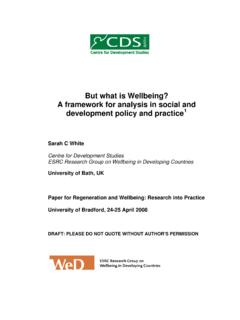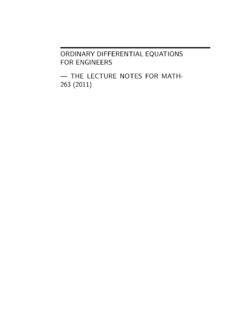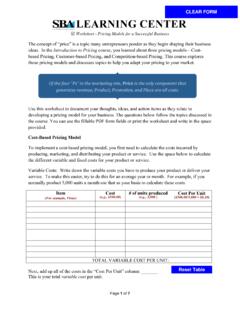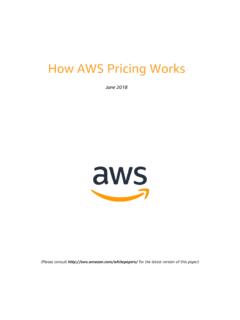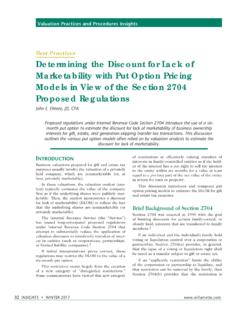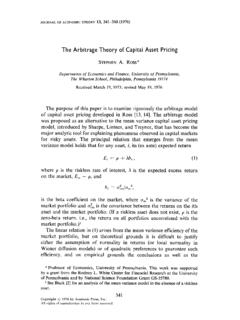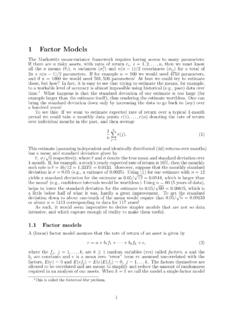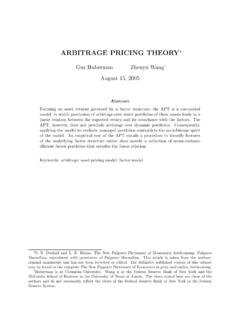Transcription of An Overview of Asset Pricing Models - University of Bath
1 An Overview of Asset Pricing ModelsAndreas KrauseUniversity of BathSchool of ManagementPhone: +44-1225-323771 Fax: +44-1225-323902E-Mail: may not be likely, please report by Andreas Krause 20012 ContentsList of Figures..iiiList of Tables..v1. The Present Value model .. The Efficient Market Hypothesis .. The random walk model .. The dynamic Gordon growth model .. Empirical results .. 122. Utility theory.. The expected utility hypothesis .. Risk aversion .. 193. The portfolio selection theory.. The mean-variance criterion .. The Markowitz frontier .. 30iiContents4. The Capital Asset Pricing model .. Derivation of the CAPM .. Critique of the CAPM .. 475. The Conditional Capital Asset Pricing model .. Derivation of the model .. Empirical results .. 586. Models of Changing Volatility of Asset Returns.. The ARCH- Models .. The relation to Asset Pricing Models .. 647. The Arbitrage Pricing Theory.. Derivation of the APT.
2 Empirical evidence .. 748. The Intertemporal Capital Asset Pricing model .. The model .. Empirical evidence .. 909. The Consumption-Based Capital Asset Pricing model .. Derivation of the model .. Empirical investigations .. International Capital Asset Pricing model .. No differences in consumption and no barriers to foreign investment Differences in consumption .. Barriers for international investment .. Empirical evidence .. Production-based Asset Pricing model .. The model .. Empirical evidence .. Influence of Speculation on Asset Prices.. Rational bubbles .. Rational speculation .. Theory of Financial Disequilibria.. Financial Disequilibrium .. Empirical evidence ..139 Bibliography..141ivContentsList of The Arrow-Pratt measure of risk aversion .. The mean-variance criterion .. The efficient frontier .. Determination of the optimal alternative .. Efficient portfolios with two assets .. Determination of the optimal portfolio with two assets.
3 Portfolio selection with three assets .. The optimal portfolio withN >2 assets .. The optimal portfolio with a riskless Asset .. Portfolio selection with short sales .. The Capital Asset Pricing model .. The Security Market Lines of the International CAPM .. 116viList of FiguresList of Assumptions of the CAPM .. Assumptions of the APT .. Assumptions of the ICAPM .. Assumptions of the International CAPM .. 100viiiList of Tables1 This book gives an Overview of the most widely used theories in Asset Pricing andsome more recent developments. The aim of these theories is to determine thefundamental valueof an Asset . As we will see in the first section there is a closerelation between this fundamental value and anappropriate return. The mainfocus of Asset Pricing theories, and therefore of most sections in this chapter,is to determine this appropriate return. The last sections will also show howdeviations from the fundamental value can be explained.
4 As the main focus ofthis chapter is on the theories, empirical investigations are only presented in veryshort, citing the results of the most prominent fundamental value of an Asset has to be distinguished from its price thatwe can observe in the market. Thefundamental valuecan be identified with thenatural priceas defined by Adam Smith. He defines the natural price to be suchthat it gives the owner a sufficient can be observed can be interpreted as themarket pricein thesense of Adam Smith. The market price is determined by demand and supply ofthe Asset and can therefore deviate from the fundamental value, but in the longrun will converge to the fundamental the focus of most theories is laid on the fundamental value Asset pricingtheories are widely used to explain observed prices. As several theories failedto explain prices sufficiently well they were modified to fit better with the gave rise to a shift in recent years from determinating the fundamental valueto explaining prices.
5 With the emergence of the efficient markets hypothesis aclose relation between the fundamental value and the price has been proposed,suggesting that the price should always equal the fundamental value. Therefore1 SeeSmith(1776, ). Adam Smith used this definition to characterize the natural priceof commodities. Therefore he had also to take into account labor costs and land applying this definition to assets, we only have to consider profits or equivalentlyreturns. He also mentions that sufficient profits depend on several characteristics of thecommodity. It will turn out that the most important characteristic is the risk of an (1776, ff.). Empirically there is strong evidence that Asset prices (andreturns) deviate from the fundamental value (and appropriate return) substantially in theshort run, but in the long run follow the fundamental it is in many cases not distinguished between the determination of thefundamental value and explaining observed prices. In many cases they are the sections that give a short Overview of empirical results concerning thedifferent Models it therefore has to be kept in mind that the aim of most modelsis not to explain prices.
6 The results have to be interpreted as how well thefundamental value of the assets explains the observed prices and not how wellthe model explains prices. Only the last two Models on speculation and financialdisequilibria want to explain prices rather than the fundamental The Present Value ModelAn Asset can be defined as a right on future cash flows. It therefore is straight-forward to assume that the value of an Asset depends on these cash flows. As weconcentrate our analysis on the cash flow of an investor, it consists of the divi-dends paid by the company, neglecting capital repayments and other infrequentforms of cash flows received by is assumed that dividends are paid at the beginning of a period, while theasset can only be bought and sold at the end of a convention canbe justified by recalling that a dividend is paid from the company s earnings inthe previous period (in most cases a quarter or year) and therefore should beassigned to the holder of the Asset in this following definition links dividends and prices:3( )Rt+1 Pt+1 PtPt+Dt+1Pt,whereRt+1denotes the rate of return of the Asset from periodtto periodt+1,Ptthe price of this Asset in periodtandDt+1the dividend paid at the beginning ofperiodt+ 1.
7 The first term on the right side represents the capital gain and the1If we assume the company to retain only the part of their cash flow that it can invest asefficient as their shareholders it is of no relevance to the shareholders whether a dividendis paid or not. If cash flow is retained the value of the Asset increases. This increase in thevalue of the company compensates the investor for receiving only a part of the company scash flow in form of a dividend. It is therefore reasonable not to distinguish between thecash flow of a company and the dividend received by the investor. If the company investsthe cash flow less or more efficient than an investor would do, the value of the company isreduced in the first and increased in the second case. Throughout this chapter we neglectany behavior of the companies or the management that can harm the investors, weassume that no agency problem et al.(1997, ).3 SeeCampbell et al.(1997, ).41. The Present Value Modelsecond term the dividend yield.
8 Solving this definition forPtgives a differenceequation for the price in periodt:( )Pt=Pt+1+Dt+11 +Rt+ this difference equation forward forkperiods results in( )Pt=k i=1[i j=111 +Rt+j]Dt+i+[k j=111 +Rt+j]Pt+ we assume the Asset price to grow at a lower rate thanRt+j, the last termconverges to zero:4( )limk [i j=111 +Rt+j]Pt+k= ( ) to increasekin ( ) we obtain the price to be thepresent valueofthe dividends:( )Pt= i=1[i j=111 +Rt+j]Dt+iEquation ( ) only holdsex-post, all future dividends and rates of returnhave to be known for the determination of the current price. In the followingsection it will be shown how this formula can be used to determine the pricewithout knowing future dividends and rates of following result fromCampbell et al.(1997, ) can easily be verified:The price of the Asset changes more with a persistent movement in dividends orrates of return than a temporary movement of the same amount. An increase individends and a decrease in the rate of return increases the current The Efficient Market HypothesisThe definition of an efficient market is given byFama(1970, ):4 SeeCampbell et al.
9 (1997, ) andAschinger(1995, pp. 39f.). A solution for thecase that this condition is not fulfilled is provided in section The Efficient Market Hypothesis5 A market in which prices always fully reflect available informationis called efficient . With this definition in an efficient market the price should always equal thefundamental value that is determined according to the information , but not necessary, conditions for a market to be efficient are:5 no transaction costs for trading the Asset , all information is available at no costs for all market participants, all market participants agree in the implications information has on currentand future prices and forms of efficiency are distinguished in the literature:weak,semistrongandstrongeffic iency. These forms differ only in the set of information that hasto be incorporated into prices. Weak efficiency uses only information on pastprices and returns, semistrong efficiency includes all public available informationand the strong form includes all information available to any market participantincluding private the information set available in periodtbe denoted t.
10 In the further dis-cussion the different forms of efficiency are not distinguished, trepresents theinformation set that suites the form this information set, a pricefully reflectsinformation if, based on thisinformation, no market participant can generate expected profits higher than theequilibrium profit:7( )E[xt+1| t] = 0,5 SeeFama(1970, ).6 SeeFama(1970, ),Campbell et al.(1997, ) andAschinger(1995, ).7 SeeFama(1970, p. 385). This also implicitly assumes that all market participants makeuse of their information to form expectations (rational expectations).61. The Present Value Modelwherext+1=Rt+1 E[Rt+1| t].Given the information set the expected returnE[Rt+1| t] equals the realizedreturnRt+1on average, there are no systematic errors in predicting futurereturns that could be used to make extraordinary profits. Using the ( ) we seethat( )Pt+1+Dt+1= (1 +Rt+1) conditional expectations on both sides and rearranging the terms we get8( )Pt=E[Pt+1| t] +E[Dt+1| t]1 +E[Rt+1| t].

